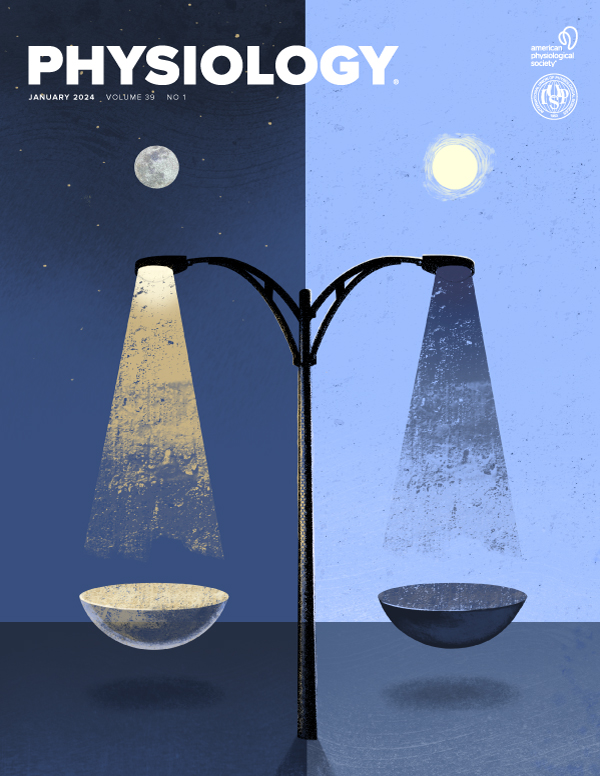光基因疗法治疗2型糖尿病心脏迷走神经功能障碍相关性室性心律失常
IF 5.3
2区 医学
Q1 PHYSIOLOGY
引用次数: 0
摘要
心脏迷走神经活动的停止与室性心律失常相关的心源性猝死和T2DM患者的高死亡率相关。尽管迷走神经刺激(VNS)已成为一种很有前景的室性心律失常治疗方法,但由于缺乏器官特异性,VNS引起的脱靶副作用严重限制了其在临床中的应用。为了避免VNS的局限性,我们采用光遗传学技术,结合微型生物光电植入物和遗传靶向策略,在T2DM大鼠中实现心脏特异性迷走神经激活。我们假设光遗传激活心脏迷走神经神经节后(CVP)神经元可以恢复迷走神经对心功能的控制,并进一步降低T2DM患者对室性心律失常的易感性。采用高脂饮食加注射链脲佐菌素诱导大鼠T2DM。AAV-channelrhodopsin-2 (ChR2, 2 μl, 5 × 1012 vg/ml)是一种兴奋性光敏感视蛋白基因,在体内转染到位于房室神经节(AVG)的CVP神经元。在视蛋白基因(即AAV-ChR2)转染三周后,通过在有意识的大鼠中无线控制和供电的LED探针,每天两次(10 Hz, 50%占空比,5 mW, 1小时)对CVP神经元进行持续光遗传刺激。我们的免疫荧光染色数据显示,在AVG中微量注射AAV-ChR2可诱导几乎所有CVP神经元中ChR2-mcherry的表达。在麻醉大鼠中,CVP神经元的光遗传激活以频率依赖的方式导致左心室收缩压负性肌力反应。心率变异性的频谱分析数据表明,光遗传刺激在体内治疗后1 - 3天逐渐恢复t2dm降低的高频功率(心脏迷走神经激活指标),而对低频功率(心脏交感神经激活指标)没有影响。此外,清醒大鼠24小时连续心电图记录的数据表明,CVP神经元的光遗传刺激改善了t2dm损伤的心室电活动异质性,这是通过在体内评估光遗传治疗后3天室性心律失常相关心电图参数来测量的。这些数据表明,CVP神经元的光遗传激活可能是T2DM状态下心脏迷走神经功能障碍相关室性心律失常的有效干预措施。本研究得到了Great Plains IDeA-CTR试点基金(发给DZ)、NIH-NHLBI (R01HL144146发给YLL)和AHA职业发展奖(851929发给DZ)的支持。这是在2023年美国生理学峰会上发表的完整摘要,仅以HTML格式提供。此摘要没有附加版本或附加内容。生理学没有参与同行评议过程。本文章由计算机程序翻译,如有差异,请以英文原文为准。
Optogenetic therapy on cardiac vagal dysfunction-related ventricular arrhythmia in type 2 diabetes
Withdrawal of cardiac vagal activity is associated with ventricular arrhythmias-related sudden cardiac death and high mortality in T2DM patients. Although vagal nerve stimulation (VNS) has emerged as a promising therapy for ventricular arrhythmias, VNS-induced off-target side effects due to a lack of organ specificity severely limit its prescription in the clinic. To avoid the limitations of the VNS, we employed an optogenetic technique that combines with a miniaturized bio-optoelectronic implant with genetic targeting strategies to achieve cardiac-specific vagal activation in T2DM rats. We hypothesize that optogenetic activation in cardiac vagal postganglionic (CVP) neurons can restore vagal control of cardiac function, and further reduce susceptibility to ventricular arrhythmias in T2DM. Rat T2DM was induced by a high-fat diet plus streptozotocin injection. AAV-channelrhodopsin-2 (ChR2, 2 μl, 5x1012 vg/ml), an excitatory light-sensitive opsin gene, was in vivo transfected into CVP neurons located in the atrioventricular ganglion (AVG). At three weeks after opsin gene (i.e., AAV-ChR2) transfection, continual optogenetic stimulation in CVP neurons was applied twice daily (10 Hz, 50% duty cycle, 5 mW for 1 hour) by illuminating a LED probe that is controlled and powered wirelessly in conscious rats. Our data from immunofluorescence staining showed that microinjection of AAV-ChR2 into the AVG induced expression of ChR2-mcherry in almost all CVP neurons. Optogenetic activation of CVP neurons resulted in a negative inotropic reaction on the left ventricular systolic pressure in a frequency-dependent manner in anesthetized rats. Data from spectral analysis of heart rate variability demonstrated that optogenetic stimulation gradually restored T2DM-reduced high-frequency power (an index of cardiac vagal activation) from one to three days after optogenetic therapy in vivo, whereas it has no effect on low-frequency power (an index of cardiac sympathetic activation). Additionally, data from 24-hour continuous ECG recording in conscious rats demonstrated that optogenetic stimulation in CVP neurons improved the T2DM-impaired heterogeneity of ventricular electrical activity, which was measured by evaluating ventricular arrhythmia-related ECG parameters at three days after optogenetic therapy in vivo. These data suggested that optogenetic activation in CVP neurons might be an effective intervention against cardiac vagal dysfunction-related ventricular arrhythmias in the T2DM state. This study was supported by the Great Plains IDeA-CTR Pilot Grant (to DZ), NIH-NHLBI (R01HL144146 to YLL), and AHA Career Development Award (851929 to DZ). This is the full abstract presented at the American Physiology Summit 2023 meeting and is only available in HTML format. There are no additional versions or additional content available for this abstract. Physiology was not involved in the peer review process.
求助全文
通过发布文献求助,成功后即可免费获取论文全文。
去求助
来源期刊

Physiology
医学-生理学
CiteScore
14.50
自引率
0.00%
发文量
37
期刊介绍:
Physiology journal features meticulously crafted review articles penned by esteemed leaders in their respective fields. These articles undergo rigorous peer review and showcase the forefront of cutting-edge advances across various domains of physiology. Our Editorial Board, comprised of distinguished leaders in the broad spectrum of physiology, convenes annually to deliberate and recommend pioneering topics for review articles, as well as select the most suitable scientists to author these articles. Join us in exploring the forefront of physiological research and innovation.
 求助内容:
求助内容: 应助结果提醒方式:
应助结果提醒方式:


